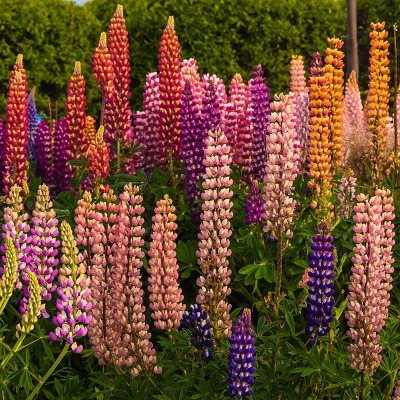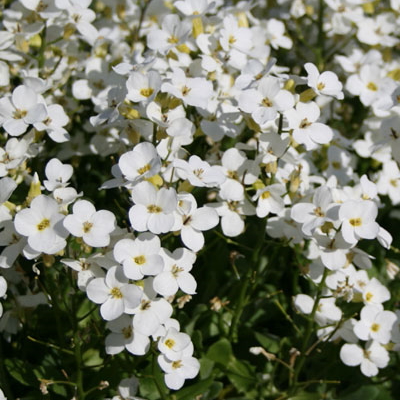-
Out of stock
 The petite 10 cm oval fruit is a bright, creamy white, about the size of a small apple, and is sweet, mild, and very tender. This variety has become almost extinct in America after being introduced here from Australia around 1930s. The small fruit is so tender you can eat it skin and all. The plants are very prolific, producing a generous number of tasty little cucumbers. Maintain regular moisture throughout the growing season and keep vines picked to encourage new fruit formation. Crystal Apple will perform well in containers or raised beds. To grow in containers choose a three to five-gallon container or larger, with good drainage
The petite 10 cm oval fruit is a bright, creamy white, about the size of a small apple, and is sweet, mild, and very tender. This variety has become almost extinct in America after being introduced here from Australia around 1930s. The small fruit is so tender you can eat it skin and all. The plants are very prolific, producing a generous number of tasty little cucumbers. Maintain regular moisture throughout the growing season and keep vines picked to encourage new fruit formation. Crystal Apple will perform well in containers or raised beds. To grow in containers choose a three to five-gallon container or larger, with good drainage -
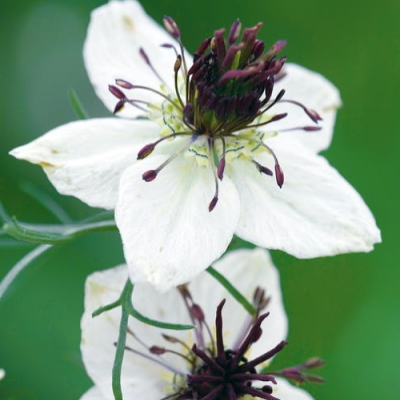
Nigella hispanica ‘Midnight’-African Bride Nigella seeds are also known as Love-in-a-Mist. Its delicate appearance belies its hardy, dependable nature. Each flower emerges from a tangle of lacy foliage. After blooming, curious-looking fruits ripen, dry, and eventually release seeds for the next season. These distinctive seed heads can be dried for flower arrangements. Everlasting flowers are grown especially for its spiky decorative seed pods. Germinates 10–14 days at 18° C. Grow on at 18-22 C. Set transplants 15-20 cm apart. For continuous bloom, direct seed weekly until June. Nigella grows 20–50cm tall.
-
-
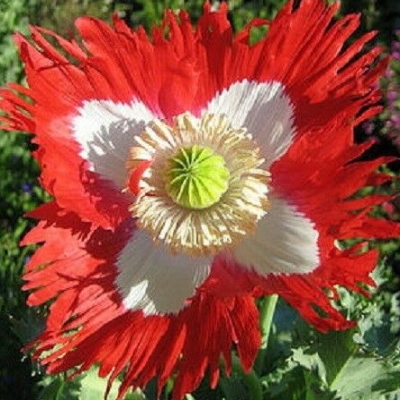 Enormous flowers reach 15 cm across. Each one is intricately crinkled and feathered or frilled, of unbelievably vivid scarlet, and at the center of each is a large, snow-white cross. The variety does indeed resemble the national flag of Denmark, which consists of a white cross on a scarlet field. Flowers attain a height of about 75 cm. Breathtaking in mass plantings! Use candlestick to seal stems when using for cut flowers to help cut blooms last longer.
Enormous flowers reach 15 cm across. Each one is intricately crinkled and feathered or frilled, of unbelievably vivid scarlet, and at the center of each is a large, snow-white cross. The variety does indeed resemble the national flag of Denmark, which consists of a white cross on a scarlet field. Flowers attain a height of about 75 cm. Breathtaking in mass plantings! Use candlestick to seal stems when using for cut flowers to help cut blooms last longer. -
 Growing quickly and easily from seed, this gorgeous and unique annual is just begging to be part of your cutting garden this year! Showy blooms are either red or blue-ringed in white, making them impossible to ignore. Petals are densely packed onto flower heads, making them long-lasting as cut flowers. (Pompon type)
Growing quickly and easily from seed, this gorgeous and unique annual is just begging to be part of your cutting garden this year! Showy blooms are either red or blue-ringed in white, making them impossible to ignore. Petals are densely packed onto flower heads, making them long-lasting as cut flowers. (Pompon type) -
Out of stock
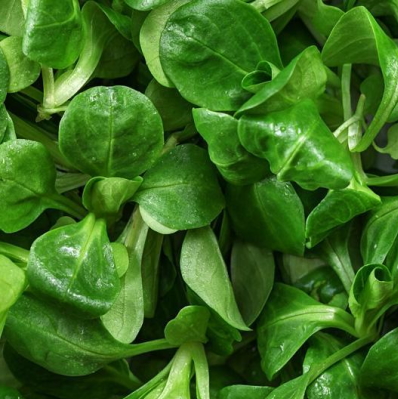 Organic, known as lambs lettuce. Long, glossy, leaves form heavy bunches with a mild flavour. Vigorous variety for spring and fall crops as well as over-wintering. Resistant to mildew. 25-35 days for small leaves and 50 days to mature. The small, pretty, tender green leaves of this green form a rosette that is very cold hardy. It has a mild and nutty flavour and can be planted in early spring and again in late August. This extra cold-tolerant vegetable can withstand temperatures up to -29C. It can be used during winters although a cold frame or greenhouse should be used if freezing rain, wind, or heavy winds are a concern. Corn Salad is one of the best crops to grow when fresh salads are to be enjoyed over the winter months. These delightful European native plants grow in autumn and even in winter when fresh vegetables are scarce. It perishes quickly after picking, usually lasting only 2-5 days in a fridge, so it is best to pick and eat the same day.
Organic, known as lambs lettuce. Long, glossy, leaves form heavy bunches with a mild flavour. Vigorous variety for spring and fall crops as well as over-wintering. Resistant to mildew. 25-35 days for small leaves and 50 days to mature. The small, pretty, tender green leaves of this green form a rosette that is very cold hardy. It has a mild and nutty flavour and can be planted in early spring and again in late August. This extra cold-tolerant vegetable can withstand temperatures up to -29C. It can be used during winters although a cold frame or greenhouse should be used if freezing rain, wind, or heavy winds are a concern. Corn Salad is one of the best crops to grow when fresh salads are to be enjoyed over the winter months. These delightful European native plants grow in autumn and even in winter when fresh vegetables are scarce. It perishes quickly after picking, usually lasting only 2-5 days in a fridge, so it is best to pick and eat the same day. -
Out of stock
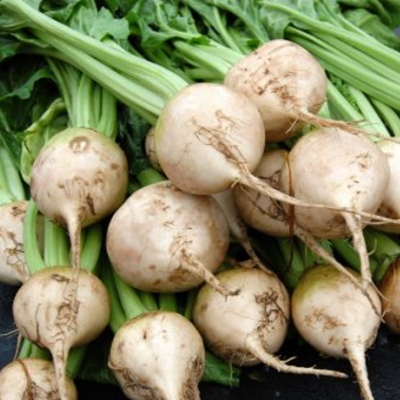
Mild and sweet white beet. Produces very round, uniform roots to harvest as a baby beet or as a mature beet. Avalanche produces mild, very sweet beets with nice white colour both on skin and flesh. Avalanche lacks the reddish skin and bitter aftertaste that other beets possess. Healthy tops have good resistance to foliar diseases. Avalanche produces consistently large, round roots with clean, vigorous tops. A great beet for daily juicing. Try juicing the whole beet it with broccoli, carrots, and apple. Very slow to go woody. 50 days to harvest at 8 cm roots. Try planting a few using our group planting method in TIP
-
Out of stock
 Cylindra Beets produce long, dark red roots. The unique roots look similar to carrots and provide more uniform slices than round beet varieties. The roots are great when used fresh, diced, canned, pickled, or frozen while the tops are great for salads. Try planting a few using our group planting method in TIP
Cylindra Beets produce long, dark red roots. The unique roots look similar to carrots and provide more uniform slices than round beet varieties. The roots are great when used fresh, diced, canned, pickled, or frozen while the tops are great for salads. Try planting a few using our group planting method in TIP -
Out of stock
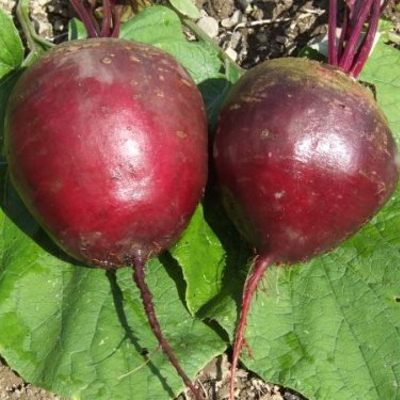 Lutz beet seeds are also known as Lutz Green Leaf. The unusually large, round roots remain sweet and tender up to 15cm in diameter. The vigorous green tops are useful for bunching in the summer. For winter storage, sow mid-July in rich soil. In the fall, cover the bed to prevent freezing. This variety makes particularly tasty micro-greens and baby leaf greens that work well in salad mixes. Its best feature is their cold tolerance and suitability as winter storage beets.
Lutz beet seeds are also known as Lutz Green Leaf. The unusually large, round roots remain sweet and tender up to 15cm in diameter. The vigorous green tops are useful for bunching in the summer. For winter storage, sow mid-July in rich soil. In the fall, cover the bed to prevent freezing. This variety makes particularly tasty micro-greens and baby leaf greens that work well in salad mixes. Its best feature is their cold tolerance and suitability as winter storage beets. -
Out of stock
 Detroit Dark Red is the perfect all-purpose beet variety. This medium-early variety produces round, dark red roots. These beets are very enjoyable, growing tender and fine-grained throughout. Ideal for use fresh, canned, pickled, and frozen. Tops are great for salads too!
Detroit Dark Red is the perfect all-purpose beet variety. This medium-early variety produces round, dark red roots. These beets are very enjoyable, growing tender and fine-grained throughout. Ideal for use fresh, canned, pickled, and frozen. Tops are great for salads too! -
Out of stock
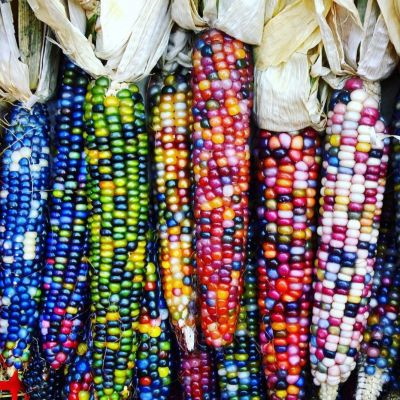 To have a successful crop you must start this corn indoors. Gorgeous translucent, jewel-colored ears, each one unique. A stunning variety selected over many years by Carl Barnes, a part-Cherokee farmer and breeder from Oklahoma. Selected from crossing several traditional corn varieties and saving seed from the vivid, translucent kernels.
To have a successful crop you must start this corn indoors. Gorgeous translucent, jewel-colored ears, each one unique. A stunning variety selected over many years by Carl Barnes, a part-Cherokee farmer and breeder from Oklahoma. Selected from crossing several traditional corn varieties and saving seed from the vivid, translucent kernels. -
Out of stock
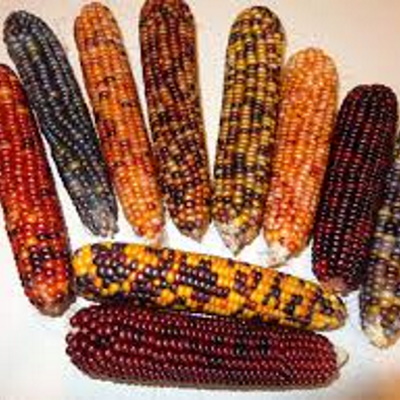 Small kernels on 15 cm, multi-coloured cobs in yellow, brown, white, purple, red, and blue. Use Calico Popcorn seeds for edible popping corn, or simply as ornaments to mark the harvest season in early fall. Give the tall, slow-growing plants as early a start as possible for the ripest cobs. Expect mixed colours on every stalk. This is not a sweet corn variety and is not intended for eating as corn on the cob. But the kernels really do pop once they have fully dried.
Small kernels on 15 cm, multi-coloured cobs in yellow, brown, white, purple, red, and blue. Use Calico Popcorn seeds for edible popping corn, or simply as ornaments to mark the harvest season in early fall. Give the tall, slow-growing plants as early a start as possible for the ripest cobs. Expect mixed colours on every stalk. This is not a sweet corn variety and is not intended for eating as corn on the cob. But the kernels really do pop once they have fully dried. -
 Aster Alpine Mix Aster Alpinus is a compact perennial with a spreading growth habit. It is easy to grow Alpine Aster from seeds, and this particular variety produces masses of lavender, blue, pink, and white flowers with yellow centers on a top of dark-green, lance-like foliage. Aster Alpine Mix blooms for several weeks from late spring and into fall providing a colorful display and attracting bees and butterflies. Alpine Aster looks gorgeous in mass planting, rock, and alpine gardens, containers, and borders. Aster Alpinus grows best in full sun to partial shade, and this drought-tolerant perennial is suitable for a low-water garden or xeriscape landscaping.
Aster Alpine Mix Aster Alpinus is a compact perennial with a spreading growth habit. It is easy to grow Alpine Aster from seeds, and this particular variety produces masses of lavender, blue, pink, and white flowers with yellow centers on a top of dark-green, lance-like foliage. Aster Alpine Mix blooms for several weeks from late spring and into fall providing a colorful display and attracting bees and butterflies. Alpine Aster looks gorgeous in mass planting, rock, and alpine gardens, containers, and borders. Aster Alpinus grows best in full sun to partial shade, and this drought-tolerant perennial is suitable for a low-water garden or xeriscape landscaping. -
-
 Arabis Snow Cap (rock Cress) Seeds have masses of tiny, snow-white fragrant flowers that appear in early spring starting April through May/June against a backdrop of evergreen foliage. The silvery-green foliage is 15-20 cm tall. Foilage provides an excellent ground cover all season long. Thin plants to 15 cm apart when transplanting or thinning out seedlings. To keep plant compact shear down all foliage after flowering.
Arabis Snow Cap (rock Cress) Seeds have masses of tiny, snow-white fragrant flowers that appear in early spring starting April through May/June against a backdrop of evergreen foliage. The silvery-green foliage is 15-20 cm tall. Foilage provides an excellent ground cover all season long. Thin plants to 15 cm apart when transplanting or thinning out seedlings. To keep plant compact shear down all foliage after flowering. -
 Aubrieta (Aubrieta deltoidea) is one of the earliest bloomers in spring. Often part of a rock garden, Aubretia is also known as "false rockcress". With its darling little purple flowers and dainty leaves, Aubrieta will scramble over rocks and other inorganic items, covering them with color and distracting the eye. Aubrieta groundcover is also remarkably drought tolerant once established and can handle the harsh heat of a full sun rockery. Read on for some tips on the care of Aubrieta and how to use this magical little plant in the garden.
Aubrieta (Aubrieta deltoidea) is one of the earliest bloomers in spring. Often part of a rock garden, Aubretia is also known as "false rockcress". With its darling little purple flowers and dainty leaves, Aubrieta will scramble over rocks and other inorganic items, covering them with color and distracting the eye. Aubrieta groundcover is also remarkably drought tolerant once established and can handle the harsh heat of a full sun rockery. Read on for some tips on the care of Aubrieta and how to use this magical little plant in the garden. -
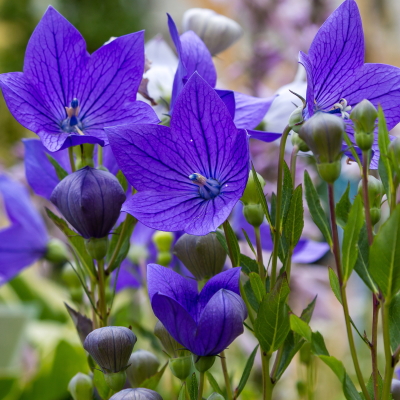
Balloon Flower (Platycodon grandiflorus) Easy-to-grow from flower seed, Balloon Flowers are an old-fashioned favorite, and they are as lovely in the garden as they are in the vase. This flower has unique star-shaped blue blossoms, and it blooms late summer and into the fall. Platycodon Grandiflorus has been around forever. The buds form like balloons and then grow until the right time to pop open and form the lovely star-shaped flower. Balloon Flower plants are very hardy perennials that can withstand periods of drought, and they are rarely bothered by disease or insect problems making them virtually a maintenance-free perennial.
-
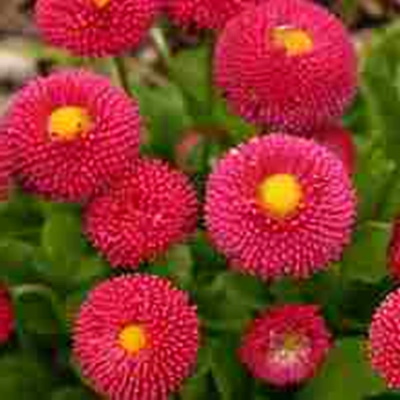
A perennial plant, grown as a biennial, 10-20 cm in height. Inflorescences with a diameter of 2-6 cm, raspberry-red color. Sow seeds for seedlings in May-June, transplanted to a permanent place in the fall. Abundant and friendly flowering of daisies occurs next year from May to August. It grows well in sunny places and in partial shade. Used for decoration of balconies, terraces, flower beds, and lawns.
-

A perennial plant 10-20 cm in height. Flowers are 2-6 cm and have multi-layered snow-white petals with a bright yellow button centre. Sow seeds for seedlings in May-June, transplanted to a permanent place in the fall. Abundant and friendly flowering of daisies occurs next year from May to August. It grows well in sunny places and in partial shade. Used for decoration of balconies, terraces, flower beds, and lawns.
-

The button-shaped flowers with double blossoms of white, pink, and rose are showy and fragrant. The small plants are dainty and attractive for spring through early summer bloom. Compact 10-20 cm plants make great for edging and in rocky gardens. Mulch heavy in winter. Plants may have single and double blooms.
-
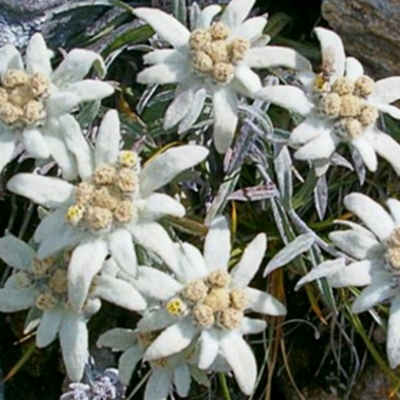 Edelweiss Leontopodium Alpinum is a famous, short-lived, herbaceous perennial native to alpine areas of Europe. Edelweiss seeds can be sown indoors 4-6 weeks before the last frost, so seedlings can be transplanted outdoors after the last frost. So-called Edelweiss of the Alps is a clamping, woolly perennial wildflower with highly attractive gray-green foliage and small yellow flowers that seat on a top of showy, fluffy, white-woolly, bract-like leaves, and this highly attractive combination is shaped like a lion's paw. Edelweiss starts to bloom in the summer. The established Edelweiss likes to grow in full sun, and cool summer climates are preferable environments.
Edelweiss Leontopodium Alpinum is a famous, short-lived, herbaceous perennial native to alpine areas of Europe. Edelweiss seeds can be sown indoors 4-6 weeks before the last frost, so seedlings can be transplanted outdoors after the last frost. So-called Edelweiss of the Alps is a clamping, woolly perennial wildflower with highly attractive gray-green foliage and small yellow flowers that seat on a top of showy, fluffy, white-woolly, bract-like leaves, and this highly attractive combination is shaped like a lion's paw. Edelweiss starts to bloom in the summer. The established Edelweiss likes to grow in full sun, and cool summer climates are preferable environments. -
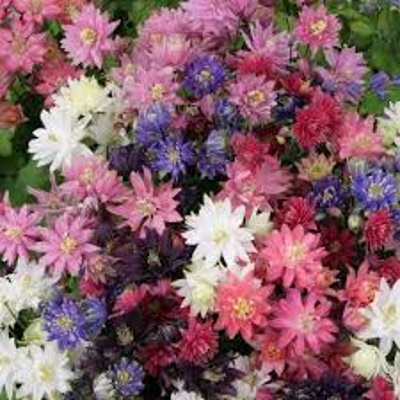
Clematis-flowered columbine. Fluffy, star-shaped blooms with pointed, overlapping petals resemble petite clematis flowers. Fully double 3-4 cm upward-facing and nodding, spurless flowers. Blooms late spring of the second year from a spring sowing. An excellent cut flower, it has strong, straight stems and fills the gap between early spring and summer bouquets. Produces multiple blooms per stem. The mix includes Victorian shades in a complementary color palette: rose, almost black, violet, deep wine red, dark purple, white, and purple-edged white. Attracts hummingbirds.
-
-
 One of the easiest native wildflowers to grow from seed, Blue Flax adds charming, light blue blooms to the early season garden. Growing to be only 45-70 cm tall, this perennial is perfect for the front of the meadow or a small space garden. Very tolerant of sandy, dry soils, Blue Flax will grow in almost any sunny spot.
One of the easiest native wildflowers to grow from seed, Blue Flax adds charming, light blue blooms to the early season garden. Growing to be only 45-70 cm tall, this perennial is perfect for the front of the meadow or a small space garden. Very tolerant of sandy, dry soils, Blue Flax will grow in almost any sunny spot.
